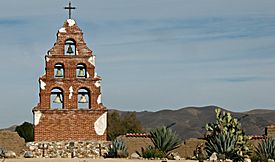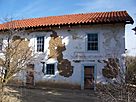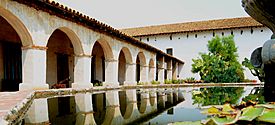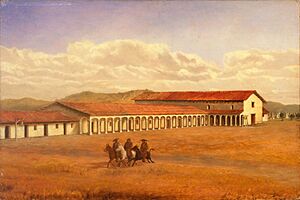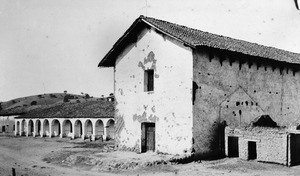San Miguel, California facts for kids
Quick facts for kids
San Miguel, California
|
|
|---|---|

Location in San Luis Obispo County and the state of California
|
|
| Country | United States |
| State | California |
| County | San Luis Obispo |
| Government | |
| • Type | Community Services District |
| Area | |
| • Total | 1.705 sq mi (4.416 km2) |
| • Land | 1.705 sq mi (4.416 km2) |
| • Water | 0 sq mi (0 km2) 0% |
| Elevation | 636 ft (194 m) |
| Population
(2010)
|
|
| • Total | 2,336 |
| • Density | 1,370.1/sq mi (528.99/km2) |
| Time zone | UTC-8 (Pacific (PST)) |
| • Summer (DST) | UTC-7 (PDT) |
| ZIP code |
93451
|
| Area code(s) | 805 |
| FIPS code | 06-68266 |
| GNIS feature ID | 1661389 |
San Miguel is a small community in San Luis Obispo County, California. Its name means "St. Michael" in Spanish. It's a place defined by the U.S. Census Bureau for statistics, and it's not officially a city. In 2010, about 2,336 people lived there.
San Miguel was started by the Spanish in 1797. This happened when Fermín de Lasuén built the Mission San Miguel Arcángel. Today, San Miguel is a fun place to visit. It has old buildings and many vineyards, which are part of the Paso Robles wine region.
History of San Miguel
Long ago, the area where San Miguel is now was home to the Salinan people. They are an Indigenous Californian nation.
The Spanish started the settlement on July 25, 1797. This was when Fermín de Lasuén founded the Mission San Miguel Arcángel. It was built under the direction of the Franciscan Order. The spot was chosen because many Salinan villages were nearby. Inside the mission church, you can see beautiful murals. These were painted in the 1820s by a famous artist named Esteban Munrás.
The mission was important because it was a stop between Mission San Luis Obispo and Mission San Antonio de Padua. Before, this trip took two days. In 1803, the mission had 908 Native American residents. They also had many animals like cattle, sheep, and horses. Most of the mission burned down in 1806 while it was still being built. But it was rebuilt very quickly, within a year.
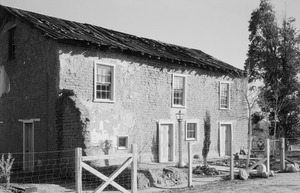
The Rios-Caledonia Adobe was built in 1835. It is just south of Mission San Miguel. It was a home for the person who managed the mission's lands.
In 1836, the Mexican government took control of the missions. Ygnacio Coronel, a well-known rancher and politician, then took over Mission San Miguel Arcángel.
In 1846, Governor Pío Pico sold the Mission San Miguel Arcángel for $600. It was bought by Petronilo Ríos and William Reed. Reed used the Mission as a home and a store. In 1848, the Mission became vacant after its owners left. It was then used by miners traveling between Los Angeles and San Francisco. It became a place for fun, a store, and living quarters.
In 1859, President James Buchanan gave the mission back to the Catholic Church. For 38 years, there was no priest living at the mission. Then, in 1878, Padre Philip Farrelly became the first pastor since it was taken over by the government. In 1928, Mission San Miguel Arcángel and Mission San Antonio de Padua were both given back to the Franciscan Order. This led to them being repaired and restored.
In 2003, a big earthquake, called the 2003 San Simeon earthquake, badly damaged the mission church. The Catholic Church thought about closing the church because of the damage. Repairs were estimated to cost $15 million. However, the repairs were finished, and the mission is now open again.
In 2011, local businesses in San Miguel created the San Miguel Chamber of Commerce. Their goal is to help promote tourism and farming in the area.
Geography
San Miguel is a small community. It covers about 1.7 square miles (4.4 square kilometers). All of this area is land.
People of San Miguel
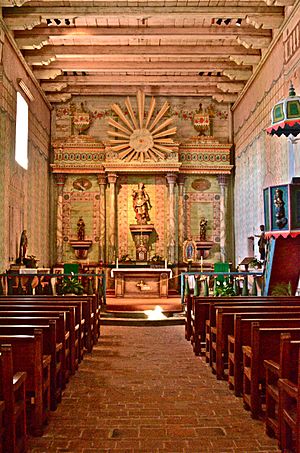
In 2010, the population of San Miguel was 2,336 people. The community is diverse, with people from many different backgrounds living there. About half of the people living in San Miguel were of Hispanic or Latino heritage.
Most people, about 99.5%, lived in homes. The average household had about 3.33 people. Many homes, about 51.3%, had children under 18 living in them.
The population included many young people. About 33.1% were under 18 years old. The average age in San Miguel was 28.3 years. For every 100 females, there were about 103.8 males.
Most homes, about 62.3%, were owned by the people living in them. The rest were rented.
See also
 In Spanish: San Miguel (condado de San Luis Obispo) para niños
In Spanish: San Miguel (condado de San Luis Obispo) para niños
Images for kids


